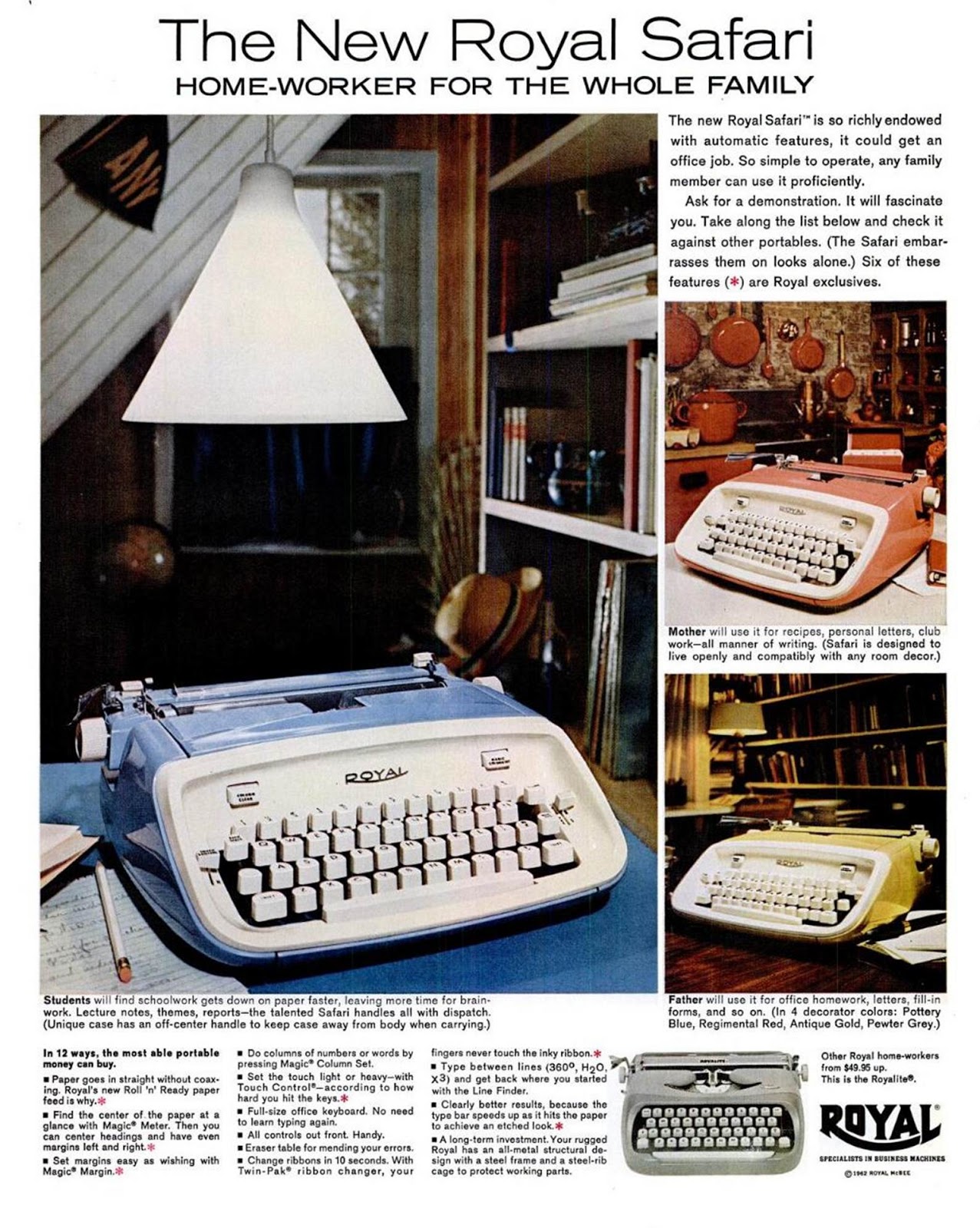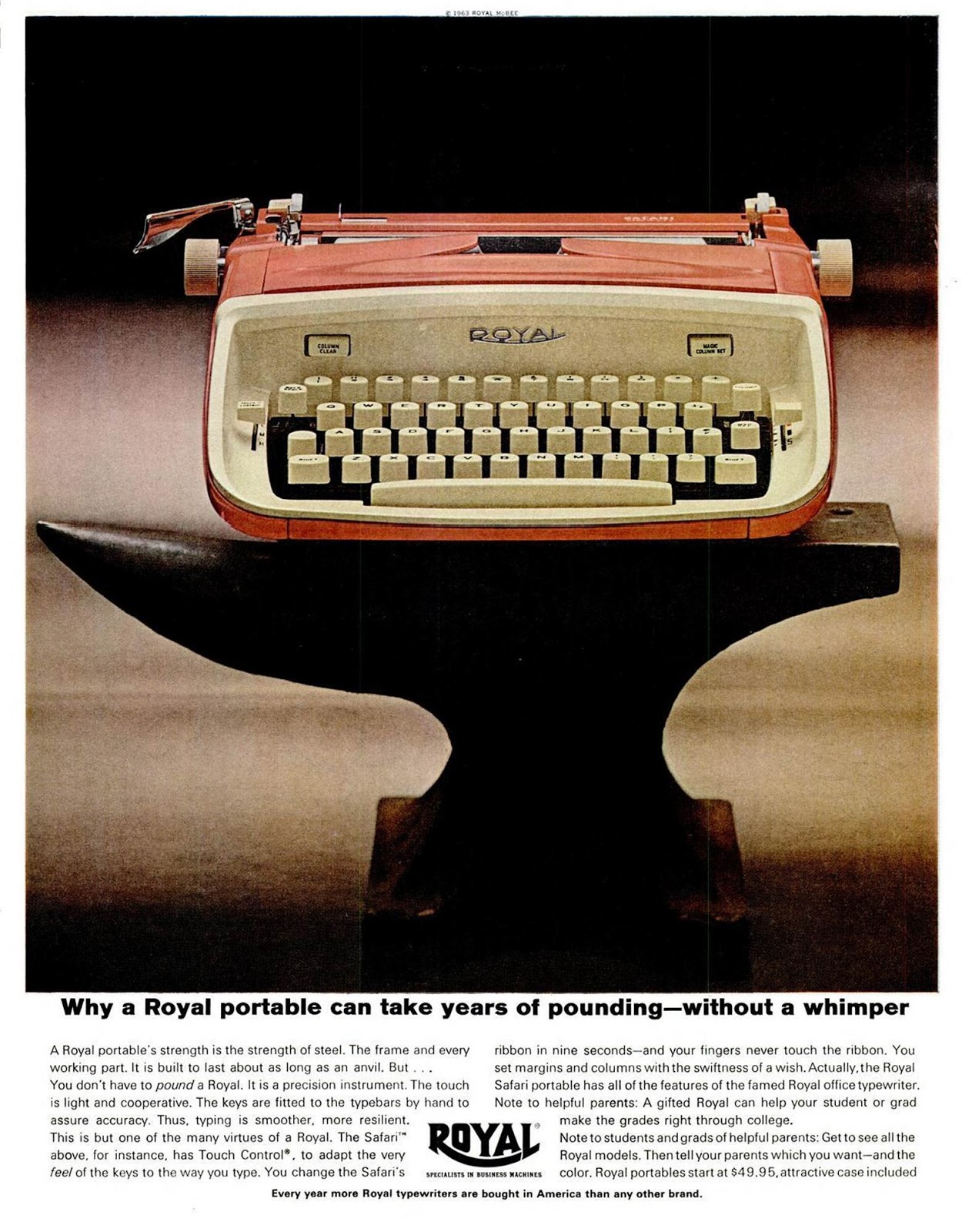↧
1963 Royal Safari
↧
Smith-Corona Corsair, circa 1963
This is a very early Smith-Corona Corsair. The three giveaways to this are the unusual carriage-return lever, the thickness of the plastic and the fact that the touch selector is under the ribbon cover, like that of the Smith-Corona Skyriter. I bought this typewriter for $20 from Bremerton Office Machines. (Mr. Montgomery asked if I thought it was worth $20 after testing it; it worked perfectly, and I love the styling. I thought it was well worth $20). The plastic shell is much thicker than that of my 1967 beige Corsair. Also, the alignment of its pica type is much more positive. The color makes it look even cuter and smaller. According to Mr. Montgomery, these typewriters generally are missing the ribbon cover and the carrying lid. He had no idea why, especially since these parts are so large.
If you look closely at the paper table, you will see tiny letters that say "Made in England".
I have no idea what these letters that were scratched into the back mean.
This lid is made out of very thick ABS plastic. (ABS is the same plastic as crash helmets, car bumpers, etc.)
This is what is contained in the lid. Its casing is just as thick as the lid.
If you look closely at the paper table, you will see tiny letters that say "Made in England".
I have no idea what these letters that were scratched into the back mean.
Mr. Montgomery's dealer sticker.
↧
↧
1962 Tower Challenger
This is my latest acquisition--a beige and brown Tower Challenger typewriter, from Bremerton Office Machines. It has been completely refurbished, and works like a breeze. The platen rubber is still soft--when I type on paper, it shows up on the roller. At some point, the carriage-return lever was replaced with one from a Royalite.
Notice the Sears logo next to the word "Tower." Tower was a brand name used by Sears, and was being phased out when this typewriter was made.
↧
August, 1951 Remington Portable
↧
1970s Underwood (Olivetti) 319
↧
↧
Identifying a 1941 Royal Quiet Deluxe
↧
"Timber Wolf Sales"
In 1970, six years after Brother International Corporation began importing typewriters to the United States, they had to tell the American public that they were not involved in any way with a sham company called "Timber Wolf Sales," who were advertising Brother portable typewriters in many national magazines for very low prices. Timber Wolf Sales consisted of three con artists, who had previously sold "land" in Canada under the name Timber Wolf Trails. Like the typewriters, the land did not exist. (For more information, check out this link: Newspaper Article )
None of the people who had ordered typewriters from Timber Wolf Sales received their typewriters. Many of them wrote to Brother International Corporation , who then informed the Council of Better Business Bureaus that Timber Wolf Sales only bought four sample typewriters, and that Brother was not consulted about Timber Wolf Sales' advertisements.
Timber Wolf Sales' advertisement is pictured below.:
If you look closely at the lettering that says "Timber Wolf Sales, you will see that it is not even close to lined-up. Also, notice that their mailing address is a P.O. Box in International Falls, Minnesota. This is visible on the upper right corner--notice that the P.O. Box is written on tape. It should be noted that the images are from a Brother International catalog. Brother International did not authorize the use of these images. (Image courtesy of the Seattle Public Library)
Below: An advertisement for Timber Wolf Trails, 1970. Like the typewriters, the land did not exist. I should also point out that Ontario is in the Northeast of Canada--not the Northwest. Looking at this advertisement, it is clear which of their operations had a higher priority--the lettering is well-lined-up, and it looks like they spent time creating this one. According to the Bureau of Labor Statistics, $12,750 in 1970 had the same buying power as $77,150.97 does in 2014.
↧
1955 Royal Quiet Deluxe--My favorite typewriter
I have always been a big fan of the 1950s Royal Quiet Deluxe portables, no matter what color they are. (Personally, I'd like a pink one, but they are always so expensive.) I like them because they are great machines to use, with a nice, light, adjustable touch, and a well-designed (although manually-set) tabulator, not to mention the Magic Margin found on so many Royal typewriters. They also have the advantage of being plentiful in the Northwest (I was told by Richard Polt that in Cincinnati, that 1950s Remington portables are very common, often appearing at thrift stores. This was also true of 1950s Royals in Seattle, until recently. Now they are very commonplace in antique shops in the Northwest.) Most look like the one below:
| This is the first view that many people have of the Royal Quiet Deluxe (if it has a case) |
| This is what is usually inside this type of case (some contain the Royal Futura) |
Generally, these typewriters are not as clean as this one was when I bought it--this is the exact condition it was in when purchased (I changed the ribbon)
Here is the back of the machine. Notice the excellent condition of the paint and the decal on the rear. Generally these are scraped from putting it in the case.
This typewriter was designed in 1947 by Henry Dreyfuss, and manufactured until the late 1950s. The only changes were made in 1950, when the glass-rimmed keys were replaced with plastic ones, and the body was made more rounded; and in 1953, when a push-button ribbon cover was introduced. In 1957, the ribbon carrier was redesigned for a quicker, less messy ribbon change. Sometime around 1954, the rear panel was redesigned, to wrap around to the sides. Around this time, the Quiet Deluxe finally received a carriage lock. This prevented damage to the carriage while being carried in its case.
According to Darryl Bridson, 250,000 Royal Quiet Deluxe typewriters were made in 1955. 200,000 were made in 1954. He also provided this ad:
↧
Torpedo 18 at the Seattle Center
↧
↧
1961 Olympia SM-7
This is one of the first Olympia SM-7 portable typewriters manufactured. (It was made so early that the case hinge consists of a tab and a slot, making the top of the case removable). Notice the finish of the dark gray on the sides--generally this has a rougher crinkle finish, but is smooth on this example. Also, notice the area near the tab-set and tab-clear keys. Generally this has the same texture as the area behind the Olympia logo, but is smooth on this particular example. The case is in relatively good condition, with only a square inch of the vinyl covering missing. It also has the names of the last two owners written in it in ink. (I'm tempted to write mine in it, too, to carry on the tradition...)
↧
Trip to Spokane, April 19
I bought this 1960 Royal Diana typewriter from Spencer's Antiques, in Spokane.
A type sample written on hotel stationery:
Quite possibly the ugliest bank building I have ever seen (and I like the SeaFirst building!)
A slightly blurry photo of the Hall of the Doges, in the Davenport Hotel
A type sample written on hotel stationery:
Quite possibly the ugliest bank building I have ever seen (and I like the SeaFirst building!)
The former Spokane branch of The Bon Marche (I love the fact that Macy's left the Bon's 1960s logo on this building)
The City Ramp Garage, completed in 1929
A slightly blurry photo of the Hall of the Doges, in the Davenport Hotel
↧
1936 Royal Model O
↧
1957 Smith-Corona Sterling with Presidential Pica
↧
↧
Mid-Century Portable Typewriter Spotters Guide
If you are interested, my book is now available in Kindle Format and in Paperback on Amazon.com. The paperback includes space for note-taking, because I had noticed that no other typewriter book has room for it.
Enjoy!
Nick
Enjoy!
Nick
↧
British Brother Portable Typewriter, March 1969
↧
My favorite typewriter
This is a typewriter that I've always dreamed of owning (especially in this color). I traded my Royal Model O for it at a vintage market--it was well worth the trade! This typewriter did not come in a case, but fits incredibly neatly in a shoulder bag. This is the first 1930s Royal I've ever owned that has had a tabulator. (Also, my first 1930s Royal that is painted a color, in this case, Duotone Brown) At some point between 1950 and 1963, this typewriter was serviced by the Wager's Office Equipment/St. Paul Typewriter Exchange (the label lists both).
Below is a flyer for the Duotone Royal, provided to me by Darryl Bridson, Royal Consumer Information Products
↧
Remington Fleetwing Typewriter
↧
↧
Acme Office Machines, 2400 N. 45th, Seattle
Acme Office Machines (Image From the Washington State Archives Puget Sound Branch, King County Assessor Property Record Card collection.)
Acme Office Machines was established in the 1950s in Seattle's Wallingford neighborhood. By 1973, Acme Office Machines had two locations--the former E.W. Hall location at 2015 3rd Avenue, in downtown Seattle, and a new Wallingford location, pictured above. Around this time, they serviced the Olivetti below:
↧
1951 Smith-Corona Clipper
↧
1955 Smith-Corona Silent Super
The dealer sticker inside the case indicates that this typewriter was sold in Seattle by Hood Wilson, located at 106 Denny Way. Notice the fact that the phone number on the sticker is only six digits long. On March 16, 1958, these had been replaced with seven digit numbers. At this time, SEneca was replaced by MAin-4.
This typewriter is painted in Desert Sand, which was a rare color for this typewriter.The ad above appeared in The Seattle Times on September 29, 1957.
Hood Wilson was large typewriter dealer in Seattle. In the early 1960s, they opened a second location in Lynnwood. From 1955 until 1957, they called themselves the "Typewriter Trading Post." By 1958, it had become the "Typewriter Super Market." They changed their name to Century Typewriter Sales around 1962. (Probably because of Century 21, the World's Fair--Hood Wilson's former building is in the shadow of the Pacific Science Center)
Here is the cover of the March, 1958 Seattle Telephone Directory:
↧







-page-001.jpg)
-page-002.jpg)


